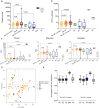No microorganism was detected in amniotic fluid of healthy pregnancies from the second trimester to the delivery
- PMID: 39849623
- PMCID: PMC11755948
- DOI: 10.1186/s40168-024-02024-3
No microorganism was detected in amniotic fluid of healthy pregnancies from the second trimester to the delivery
Abstract
Background: The early colonization and establishment of the microbiome in newborns is a crucial step in the development of the immune system and host metabolism. However, the exact timing of initial microbial colonization remains a subject of ongoing debate. While numerous studies have attempted to determine the presence or absence of intrauterine bacteria, the majority of them have drawn conclusions based on sequencing data from maternal or infant samples taken at a single time point. In this study, we aimed to investigate the microbial population in amniotic fluid (AF) from the second trimester until the time of delivery using multiple microbiological methods.
Methods: AF samples were collected during the second trimester (19-21 gestational weeks) and at the time of delivery. Cohort 1 included 51 women who underwent the term and elective cesarean section, with both their second trimester and delivery AF samples (n = 55, respectively) analyzed. Cohort 2 contained 22 women who experienced infection-related adverse pregnancy outcomes (including preterm birth, histological chorioamnionitis, and stillbirth), with only their second trimester AF samples (n = 24) examined. Additionally, multiple procedural negative controls and technical positive controls were applied to this study to remove potential contamination. Microbial profiles were assessed through cultivation, quantitative real-time polymerase chain reaction, 16S ribosomal RNA gene sequencing, and cytokine analysis.
Results: In cohort 1, the bacterial load and community structure in the second trimester AF samples were indistinguishable from negative controls. Although marginally higher bacterial loads and different bacterial communities were observed in the delivery AF samples compared to negative controls, these bacterial DNA were not considered biologically functional due to the absence of maternal inflammatory responses. In cohort 2, the bacterial load and community structure of the second trimester AF samples differed significantly from those of negative controls, with Ureaplasma and Lactobacillus identified as the most prevalent genera against negative controls.
Conclusions: Our study demonstrates that no microorganisms were detected in the AF of healthy pregnancies from the second trimester to the delivery. The presence of Ureaplasma and Lactobacillus in the second trimester AF may be associated with infection-related adverse pregnancy outcomes. Video Abstract.
Keywords: Amniotic fluid; Bacteria; Infection; Pregnancy; Preterm birth.
© 2025. The Author(s).
Conflict of interest statement
Declarations. Ethics approval and consent to participate: This study was reviewed and approved by the institutional ethics committee of Peking University First Hospital (2015[886]), and all the participants provided written informed consent. Consent for publication: Not applicable. Competing interests: The authors declare no competing interests.
Figures




Similar articles
-
Antibiotic treatment reduces the intensity of intraamniotic inflammation in pregnancies with idiopathic vaginal bleeding in the second trimester of pregnancy.Am J Obstet Gynecol. 2024 Feb;230(2):245.e1-245.e14. doi: 10.1016/j.ajog.2023.07.041. Epub 2023 Jul 28. Am J Obstet Gynecol. 2024. PMID: 37516399
-
Midtrimester amniotic fluid from healthy pregnancies has no microorganisms using multiple methods of microbiologic inquiry.Am J Obstet Gynecol. 2020 Aug;223(2):248.e1-248.e21. doi: 10.1016/j.ajog.2020.01.056. Epub 2020 Feb 1. Am J Obstet Gynecol. 2020. PMID: 32017922
-
Microbial signatures in amniotic fluid at preterm birth and association with bronchopulmonary dysplasia.Respir Res. 2023 Oct 16;24(1):248. doi: 10.1186/s12931-023-02560-w. Respir Res. 2023. PMID: 37845700 Free PMC article.
-
Is amniotic fluid of women with uncomplicated term pregnancies free of bacteria?Am J Obstet Gynecol. 2018 Sep;219(3):289.e1-289.e12. doi: 10.1016/j.ajog.2018.05.028. Epub 2018 May 29. Am J Obstet Gynecol. 2018. PMID: 29852156
-
Questioning the fetal microbiome illustrates pitfalls of low-biomass microbial studies.Nature. 2023 Jan;613(7945):639-649. doi: 10.1038/s41586-022-05546-8. Epub 2023 Jan 25. Nature. 2023. PMID: 36697862 Free PMC article. Review.
Cited by
-
Association of specific microbiota taxa in the amniotic fluid at birth with severe acute and longer-term outcomes of very preterm infants: a prospective observational study.BMC Med. 2025 Jul 18;23(1):431. doi: 10.1186/s12916-025-04259-9. BMC Med. 2025. PMID: 40682023 Free PMC article.
-
Gestational diabetes mellitus alters neonatal gut microbiota and increases infection susceptibility.Front Microbiol. 2025 Jun 23;16:1600325. doi: 10.3389/fmicb.2025.1600325. eCollection 2025. Front Microbiol. 2025. PMID: 40625618 Free PMC article.
References
-
- Wang S, Ryan CA, Boyaval P, Dempsey EM, Ross RP, Stanton C. Maternal vertical transmission affecting early-life microbiota development. Trends Microbiol. 2020;28(1):28–45. - PubMed
MeSH terms
Substances
LinkOut - more resources
Full Text Sources

